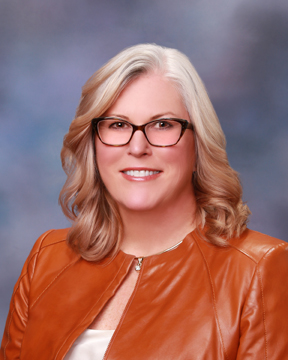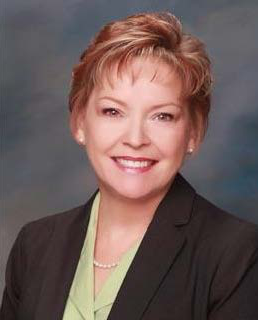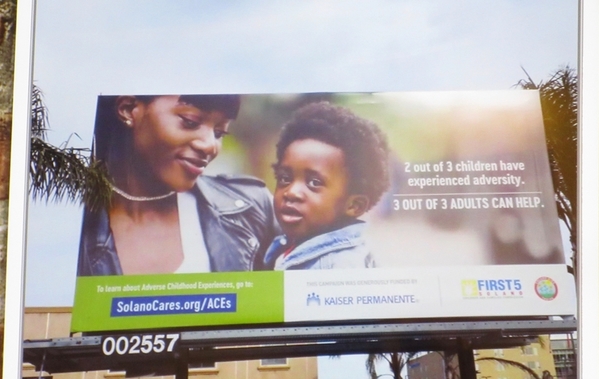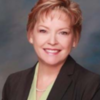L-R Maria Guevara, Karen Ketchum, Tara Khawaja
In a house called “Johanna’s House” on a tree-lined side street in Vallejo, Calif., four women are filling out the adverse childhood experiences (ACE) survey given to them by Maria Guevara, the founder of Vallejo Together, an organization that serves homeless residents in Vallejo. The house was named for Johanna Dilag, a homeless woman who was found dead along with her dog. She died in 2012 when her heart stopped due to malnutrition, according to the Solano County Coroner’s office.
The ACE survey comes from the landmark Centers for Disease Control and Prevention/Kaiser Permanente Adverse Childhood Experiences (ACEs) Studythat found stark and substantial links between 10 different types of common childhood traumas — such as divorce, living with parent who’s dependent on alcohol or is depressed, divorce, or experiencing verbal abuse — and the adult onset of chronic disease, mental illness, violence and being a victim of violence. Each type of ACE counts as 1 in an ACE score. Researchers found that an ACE score of 4, for example, increased the risk of alcoholism by 700 percent and suicide attempts by 1200 percent compared with someone who has an ACE score of 0, according to a study in the Journal of Preventive Medicine. An ACE score of 4 or more was associated with twice the risk of heart disease and cancer. And an ACE score of 6 was linked to a life cut short by 20 years compared to someone with 0 ACEs.(For more information, go to ACEs Science 101. To calculate your ACE and resilience scores, go to: Got Your ACE Score?)
In Solano County, Solano Kids Thrive has built a radical plan — with community input — to heal from the impact of ACEs in the county, and prevent ACEs. The collaborative’s members include educators, healthcare providers (including mental health), parents, nonprofit organizations, and social services.
Up and down the county, Solano Kids Thrive members gave 23 presentations to 450 people about how toxic stress can throw a child’s brain into fight, flight or freeze mode, and how building resilience in a child through the help of just one caring adult can help children with ACEs heal. The group, which has been laying the groundwork for its county-wide ACEs initiative since 2016, shifted its focus at a Resilient Solano summit held May 18 from raising awareness about ACEs and resilience to inviting the community to join them in building an action plan.
As part of its awareness campaign, Solano Kids Thrive held 15 different screenings of the film Resilience: The Biology of Stress & The Science of Hope, attended by 1,000 people. The documentary details ACEs science how toxic stress in childhood can impact brain development and lead to chronic health problems, and how an international effort is afoot to prevent and mitigate ACEs.
For Guevara, who saw Resilience at one of those screenings at Kaiser Permanente in Vacaville, Calif., the film and learning about ACEs was transformative. “I thought it was one of the most amazing events that I have ever seen because it actually touched on the heart of the matter as to why children, who, of course, grow up to be adults if they’re blessed, have these types of issues growing up,” says Guevara.
“[The ACE survey] is something that’s revolutionary because it’s a simple 10-question test that defines someone’s life that can actually help them process that it’s not them who is responsible but the experiences around them. So, it actually takes out that guilt and shame and it helps adults define what they’re going through. So, I thought it was just revolutionary!” says Guevara whose organization, she says, serves around 1,000 people in Vallejo each year who are homeless.
Guevara said after viewing the film she’s felt a sense of urgency to educate the people served by her program about ACEs and resilience and embed it in all of Vallejo Together’s programs. These include a mobile medical unit operated with health care providers from Kaiser Vallejo and Touro University, a day service center for homeless residents, and two other transitional homes. The residents of the homes volunteer 10 hours monthly to hand out food and clothing donations to their “friends” as Guevara calls residents who live on the street in Vallejo. The programs run on what Guevara described as “a really low” budget of private donations, some coming from friends and family.
The four women filling out the ACE survey around an oval dining room table were also recently homeless. They are Loren Jones, Tara Khawaja, Karen Ketchum, and another woman who requested anonymity to protect her privacy. In between the streets and Johanna’s house, three of the women had spent time in a local rehab center known as Shamia Recovery Center to help them undo the grip of addiction on their lives.
The women go around the room and share their ACE score, as does Guevara. “2,7,3,1,2.” Taking stock of all of their scores, she tells them, “It’s what happened to you and not what you did. Because for the most part with trauma there’s guilt and shame and (a feeling of) kinda like was it my fault.”
The comment about shame resonates for Lauren Jones, who later mentions how shame impacted her. “I was too ashamed to contact my mother and sister when I was on the street,” says Jones, who used drugs to cope with her father’s death. He died when she was 13. “That was the most traumatic thing of my childhood that I think still affects me,” says Jones, who recently finished an iron workers' training program, following in the footsteps of her father, who was an iron worker.
The connection between ACEs and using drugs as a coping strategy also rang true for Karen Ketchum. “If you don’t care about yourself and use drugs to medicate it at 11, 10 years old, 9 years old as I did, you stop learning at that point. So, I’m walking around in a 50-year-old body with the mind of an 11-year- old child. And to this day, you see where I’m at. I’m at a clean and sober living and mental health home. I just got out of jail. I just got out of a treatment facility, once again, and I can’t seem to grasp the concept of living in the real world and paying bills. I’ve never done that because of childhood molestation,” she says, adding that based on her own conversations with women while in prison, the majority had also experienced sexual trauma.
Reflecting on what could help undo the lifelong impact of trauma, Tara Khawaja says, “It’s really something that should be talked about. It should be addressed more often.”
In fact, the awareness campaign by Solano Kids Thrive has worked to make talking about ACEs less fraught and easier, according to Lisa Eckhoff, the director of Early Learning at Solano County Office of Education. Educating people about ACEs is about “trying to erase some of the negative stigma that’s attached to having ACEs and emphasize the hope of resilience,” she says.
And to reach out to other residents in the county, Solano Kids Thrive plastered billboards and posted ads on buses that crisscross the county, all with the basic message that the positive influence of an adult can make a difference in the life of a child experiencing ACEs. One showed a mother beaming at her baby framed by the words “Adversity strikes 2 out of 3 children; 3 out of 3 adults can help.” They have been running similar ads on the popular music app Pandora from October 2018 to June 2019.
Juan Cisneros, the family community partnership director of Child Start Inc., has been one of the Solano Kids Thrive members presenting ACEs science presentations around the county. He remembers his initial reaction to learning about the ACE Study. “With my ACE score being a 6, things began to make sense to me in terms of my own health and well-being. I began to understand why Kaiser was asking me some of the same (ACEs) questions during a routine check-up. I also reflected on who was there for me growing up that prevented me from downward spiraling or engaging in risky adolescent and adult behaviors. I know that, even though we can train the mind to forget, the body does not forget…so I was reminded that I still have work to do so that I can truly begin to heal.”
The county’s effort began in 2016, explains Megan Richards, the deputy
director of First 5 Solano, which has spearheaded the work. One of the group’s realizations early on was that for such an ambitious project to work — that of preventing or mitigating ACEs and building resilience — it couldn’t be siloed in one sector. “Because if you have a family that experiences trauma it will have an impact on their health, their mental health, their ability to learn, the family’s sustainability,” says Richards.

And part of their plan was also ensuring that there were influencers on board. An obvious choice was Solano County Supervisor Erin Hannigan, who also serves as a First 5 Commissioner. Hannigan was introduced to ACEs while moderating a panel discussion a couple years ago for First 5 following a screening of the film, Resilience. “It was an eye opener for me and something we needed to expose as many people in our community to as possible.”
At the Resilience screening and panel she moderatedACE surveys were included in handouts. And Hannigan filled out hers. “It was profound. I was self-reflective. I determined I had 4 indicators and looked back on my life and how that affected my decisions.”
And Hannigan, who represents Vallejo, says her community is heavily impacted. “The community that I represent draws on an enormous amount of health and social services that the county provides. Instead of looking at here’s a policy or a budget item, it’s really diving down: How can we make a sustainable change in a young child’s life that can really have a 360 effect in terms of addressing the needs of their parents or caregivers and eliminating or limiting the number of adversities they may be subjected to?”
In terms of next steps, Hannigan says she’s eager to hear about input from constituents who participated in the Resilient Solano Summit on May 18.

Solano County Superintendent of Schools Lisette Estrella-Henderson has also been on the forefront of spreading the word about ACEs science in the community and in schools. “We’ve been showing the film Resilience and doing training for our schools in resilience and ACEs science and looking at age specific, developmentally appropriate strategies for training in trauma informed care,” she says.
While she doesn’t have data, she says, “Anecdotally we hear from educators that they are better prepared to address children coming to school with ACEs. Parents are gaining better strategies for how to enable children to be resilient, and there have been a reduction in referrals to offices and chronic absenteeism.”
But Henderson says there is still a lot of work to be done. If she had any advice for her peers at her level in other counties, it’s related to leadership buy-in. “It’s really about superintendent leadership and mindset and knowledge,” she says. “Because I believe once we know about the impact that ACEs have on a child in school and in the community, we can’t say we don’t know.”
Vallejo Together’s Maria Guevara reflects back on her introduction to the ACEs survey. “It made me kind of sad that we had to wait so long for something so simple to identify peoples’ pain,” she says. ” But at the same time, it made me glad that the time was now and that I have a sense of urgency and excitement about it.”





Comments (0)